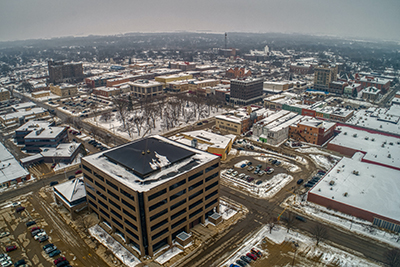
Mason City is providing grants to help in the development of a 102-unit apartment complex downtown. The River II is the second iteration of the River, a 133-unit housing complex developed as “Workforce Housing.” The new project comes as Mason City Council ushers in approval for various infrastructure and housing projects.
The River I saw its opening in January of this year, with a ribbon-cutting ceremony led by Talon Group developers and city leaders. The original housing complex is a 4-story brick-veneer building with steel balconies protruding from the facades. It’s amenities include a gym, indoor bike lockers, parking garage, and community services such as a lounge, meeting room and dog wash.
Talon CEO mentioned adding to what he calls Mason City’s ‘stock’ of workforce housing by building the River 2. Additionally, Colliers Mortgage also provided a loan to refinance the River I. The 10-year loan is worth $12 million and is set on a 30-year amortization schedule.
Council members voted unanimously to award a grant to Talon that would serve as a “Workforce Housing Tax Credit” valued at 1 million. The city also proposed a 10-year, 100% tax reduction worth more than 2 million. Mason City Administrator Aaron Burnett justified the credits in a recent city council packet, citing the significantly higher cost of materials.
The River 2 is located adjacent to the south loop of Highway 65 which will see its own improvements by 2024. These include new turn lanes, revamped ADA ramps, and a new storm sewer system. These new developments will surely help to make its real estate market more resilient. And the city hopes to continue it’s resurgence with population growth. There are many Mason City homes for sale at fair prices and in incredibly attractive locations.
Material shortages drive up prices
In June of this year, the National Association of Home Builders (NAHB) reported widespread and deepening shortages of materials. Shortages invariably mean higher building costs and more expensive homes.
Matt Gordon is in the hardware and lumber business and commented on the uncertainty of material prices. “A lot of the insiders I deal with think it’s short-term,” he said. “ But I hope we can get back to some regular numbers.”
Low interest rates that meant many homeowners could refinance their mortgages also gave rise to many new homes. DIYers also purchased more material to make improvements on their homes, fueled by the stimulus checks. This resulted in low inventory, and with workers stuck at home under quarantine, there was soon short supply.
According to the NAHB, average home prices increased by $36,000 in the past year due to price hikes. In late 2019, a standard 4-by-8 sheet of strand board cost only $8, but in the middle of this year each board cost $57. Jonesboro developer Bob Troutt is optimistic that prices will come down, however:
“Prices are coming down, but they’re never going to go back to $8 a sheet. But if they get to $18 to $20, builders could live with that,” he said. “Some builders are playing musical chairs, but they can’t quit. If they ever quit, there won’t be a seat for them.”
A resilient real estate market in Mason City
Somehow, Iowa managed to weather the pandemic storm and maintain a healthy real estate market, meaning enough homes for sale. This is due, in part, to low federal interest rates and people needing more space. This includes bigger yards, as well as bigger homes since many have spent more time at home than they ever did before.
Many real estate agents and brokers wondered whether the market would continue to move, or if it would slow to a halt. “However, housing is a basic and essential need,” said Diana Symonds, President of the Greater Mason City Board of Realtors.
“Our governor worked with the Iowa Association of Realtors to make sure the industry had everything necessary to continue selling and closing on homes.”
Historically low interest rates also helped to create a climate that benefits both buyers and sellers. With fewer people selling their homes, there was greater demand and so real estate brokers saw more clients coming in. This also meant that with so many buyers looking at homes for sale, which meant it was also a seller’s market.










